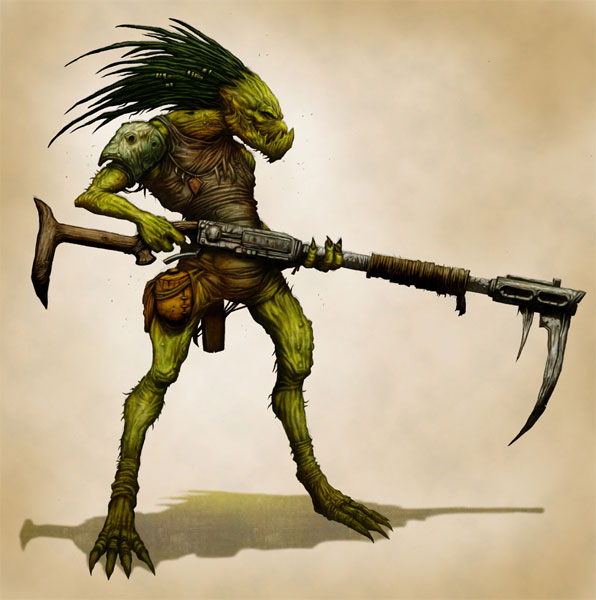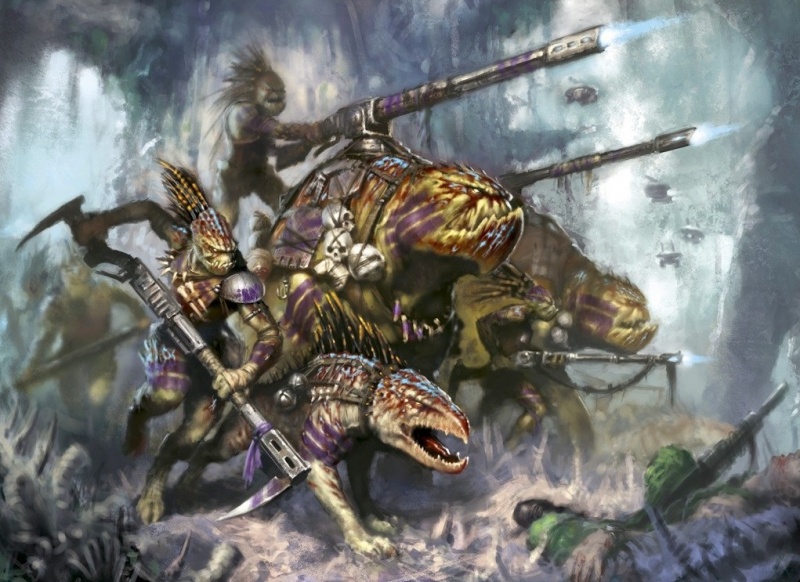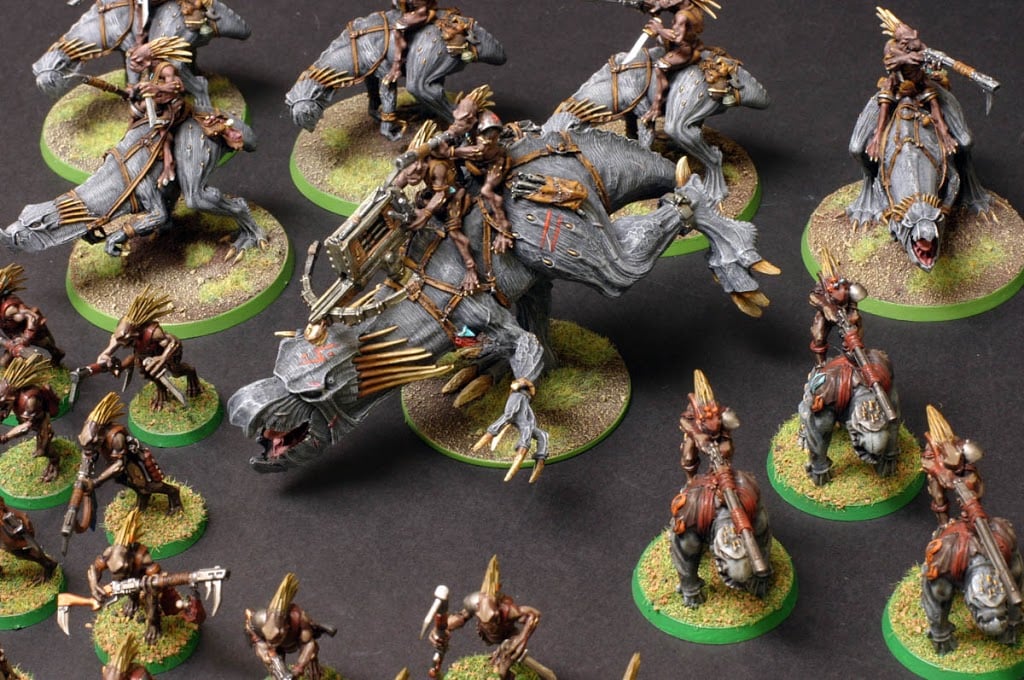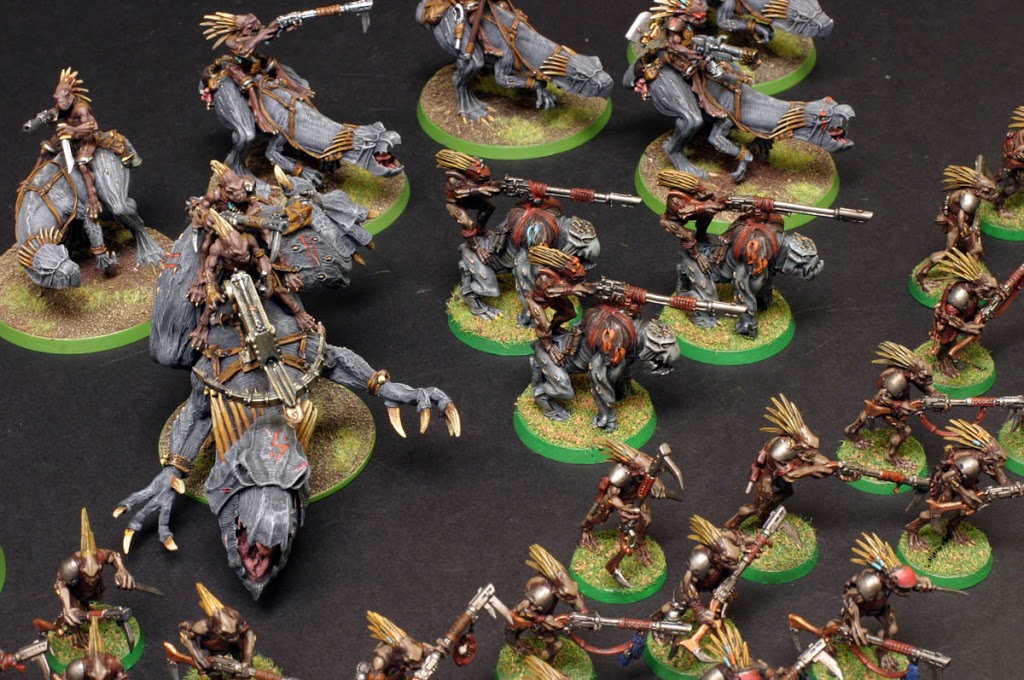40K Lore: Tau Allies – The Kroot


Today we delve deep into the ferocious and most numerous allies of the Tau Empire – The Kroot Carnivores!
The Kroot (scientific name Krootis aviana, referenced by the Imperium as Kroot Carnivore) are a humanoid species of xenos. They appear throughout the galaxy, but are most frequently associated with the Tau Empire.
Biology and Appearance
The Kroot originated on the world of Pech and, though their physiology is humanoid, there is evidence to suggest that the roots of their evolution may be avian in origin. They retain vestigial beaks and have a light, almost hollow bone structure, with four digits on each hand and foot. Their skin is rough with small, barbed spines, similar to the elongated quills on their heads, protruding from various locations on their flesh. Skin pigmentation ranges from earthy brown colours and dappled greens to vibrant oranges and everything in between. Depending on the feeding directions of the Kroot Shapers, the colouration of each kindred can vary quite considerably. It is also common for Kroot from each kindred to have particular tribal markings painted onto their skin. Kroot mature quickly, with their most rapid period of growth occurring in the first ten years of their lives. By the age of twelve they are considered adults and it is not unknown for Kroot to live to over a hundred years old, their skin becoming increasingly pitted and leathery in their last few years of life.[Needs Citation]
Kroot are tall and their bodies have a wiriness to them that appears deceptively fragile. In actuality, Kroot musculature is extremely powerful and composed of dense fiber spindles with a greater power‑to‑mass ratio than is found in humans. Swift muscle contractions create a whiplash effect, allowing the Kroot to deliver powerful blows with great rapidity. On the ground, the Kroot tend to move with a bounding, hopping gait, but in dense forests, they can spring from tree to tree at great speed. The Kroot favour primitive garb: harnesses worked from the hides of animals and adorned with bones, handcrafted amulets and circlets.[9]

The limited specimens that have been made available for study are found to have brains composed of a front and rear hemisphere. It appears that the larger, frontal hemisphere controls the functions of logic, reasoning and memory while the rear, less developed hemisphere is more attuned to imagination and creativity. If this is indeed the case, it would go some way to explaining the pragmatic approach to life of the Kroot and their current technological stagnation.
The Kroot head is crowned with a great mass of tough, flexible quills that appear to be a part of the Kroot’s sensory apparatus. These quills contain what seem to be ganglia running from the frontal lobes of the alien’s brain and, in this position, would be extremely efficient at receiving and interpreting information on the surrounding environment. The olfactory cavity within the Kroot skull is also enlarged, with multiple sense organs within both it and the mouth. Their eyes are without pupils and generally a milky white. It is likely that they are able to see further into the infrared end of the spectrum and can sense the body heat generated by their prey. Therefore, the Kroot make excellent trackers and would be extremely difficult to sneak up on.
The Kroot generate little in the way of waste, excreting in the form of a pungent, oily sweat that has a variety of properties, depending on what the Kroot has consumed. The most apparent benefits are that this sweat appears to be heat-retardant to a degree, has antibiotic properties and can cause a poorly-aimed blow to slide clear. It is suspected that the Kroot can alter the properties of this secretion in order to leave pheromone trails, mark territories, leave warnings and even communicate with one another. This may also be some form of control that extends to lower life forms such as birds and animals, as there is evidence to suggest that the Kroot employ empathic pheromones to prevent such creatures from being startled by them and giving away their position in battle. Combined with this method of communication, the Kroot can learn new languages at an astounding rate, matching posture and tone to the sound of foreign words in order to discern their meaning. Their own verbal communication is a mixture of clicks and whistles, possibly reinforced by these pheromone exudations.
Shaping
A unique feature of the Kroot is that they evolve by absorbing the traits of other species, a process accomplished by eating their flesh. Due to this, the many Kroot warbands across the galaxy often look radically different. Kroot leaders are known as Shapers; they are generally the Kroot with the instinctive ability to recognising desirable or detrimental traits in defeated foes and instruct his kindred what to eat to suit the task at hand. For instance, a Shaper who wants his Kroot to gain muscle mass will take on campaigns against Orks to acquire the right DNA, while extensive feeding on flying predators will allow the Kroot to grow wings.
This eating of their foes ties in with the religious beliefs of the Kroot: they believe that when a warrior of any race dies, his warrior spirit should be kept, and the only way to do this is by eating his flesh. The Kroot practice this in their “burial” customs, in which the body of the deceased is consumed by the kindred.
Kroot who prey extensively on a particular species will begin to take the characteristics of that creature. In sentient species such as Orks and Humans, they may also take on cultural aspects of that race as well. Kroot who have fed on Dark Eldar, for example, soon begin to show signs of the cunning and intense cruelty the Dark Eldar are known for.
The Kroot digestive system is extremely efficient, capable of breaking down almost any organic material into an energy form that can be stored in specialised organs scattered throughout their bodies, called nymnes. Should anything inorganic and indigestible be consumed, the Kroot must regurgitate it, with considerable discomfort.
However the strangest quirk of Kroot digestion is their ability to extract potentially useful strands of their food’s DNA. Adeptus Mechanicus Genetors have long been aware that much of the double helix structure of DNA is in fact blank and used to separate those areas that do contain genetic information. The Kroot have somehow inherited the ability to incorporate useful DNA codes into their own genetic makeup.
The process is not an exact science and there are many examples where it has gone awry, leaving some trapped in evolutionary cul-de-sacs, the Krootox and Kroot Hounds being the most visible evidence of this. At some point in their evolutionary history, both sub‑species of Kroot fed upon creatures that were possessed of traits they wished to take on, but, in doing so, atrophied their intelligence. These Krootox are now much larger and stronger, but became lumbering creatures, more akin to forest-dwelling herbivores than their smaller, more intelligent kin. The Kroot Hounds became faster and leaner but, like the Krootox, their intelligence was reduced, becoming little more than vicious predators. The Kroot use these variants of themselves as labourers, pack animals, mounts, and even as weapons, especially the gargantuan Knarloc.
There are other variations, such as the smaller, flying Kroothawk (which is revered by Kroot as a possible evolutionary ancestor) and the serpentine Krootworm, as well as other, more terrifying, creatures. Deep within the forests of Pech, there exist beasts that were once Kroot, but have since descended hideous evolutionary paths to become monsters that feed on their own kind. Such places have become cursed and only the bravest or most foolhardy Kroot ever venture within their haunted depths.
There are at least three species which Kroot are forbidden to eat:
- Tyranids, which the Shapers have declared inedible (which means something far more horrible to a kroot than it does to a human), and because the Shapers are inherently repulsed by the Tyranid’s particular way of changing their genetic makeup.
- Humans who worship Chaos (though this is a bit of a hit and miss affair, such cultists being hard to distinguish from the average human).
- The Tau, due to their role in saving the Kroot’s homeworld of Pech from Orks; consuming Tau flesh is a crime that brings swift and deadly retribution from the Shapers.
Kroot are able to “taste” the taint in the meat of dead Genestealer hybrids, even if the mutations are not visible.
They are unable to effectively shape the living metal of the Necrons, and doing so produces hideous effects as was demonstrated on Caroch.
History and Culture
In order to gather genetic material from all over the galaxy, the Kroot offer themselves as mercenaries, and sell their services to anyone willing to pay them. They travel the galaxy taking limited contracts from both major and minor races, and are regularly employed by the Tau. While the contract with the Tau is supposed to be an exclusive one, the Kroot regularly send out their Warspheres to continue their mercenary trade amongst the wider cosmos.
Union with the Tau
In order to combat the Orks, who occupied much of the Kroots core worlds (including their homeworld of Pech), the Kroot agreed to establish an alliance with the Tau Empire in 844.M38 at the behest of Anghkor Prok. Within a decade of their first battle side-by-side (known as the War in the Place of Union), the Tau and Kroot had jointly liberated Kroot from the greenskins. Since then, the Kroot core worlds have fought loyally for the Tau and Greater Good, provided they receive sufficient payment.
Learn MUCH more about the Kroot
(Lexicanum)
Do you use Kroot in your Tau armies?




